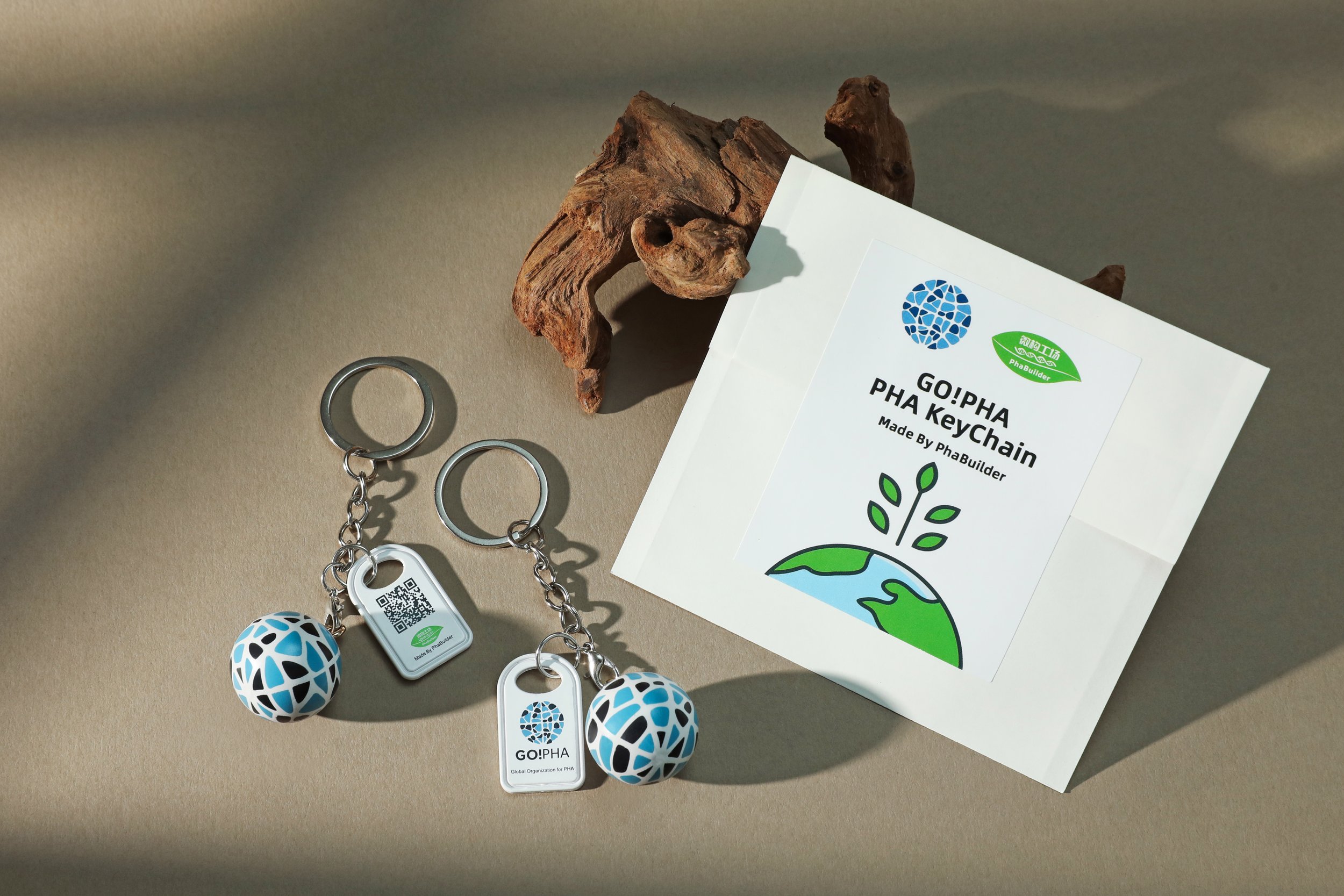
The PHA Keychain
Introducing the PHA Keychain, produced and designed by PhaBuilder in partnership with GO!PHA. Crafted from Polyhydroxyalkanoates (PHA), this keychain is a tangible example of how bio-based, biodegradable and compostable materials are being used to rethink everyday products.
The Journey of the PHA Keychain: From Fermentation to Finish

The PHA Keychain is the product of a collaboration between PhaBuilder and GO!PHA, bringing together their combined expertise in bio-based, biodegradable, and compostable materials, as well as their shared commitment to sustainable solutions. PhaBuilder’s technical proficiency in producing PHA (Polyhydroxyalkanoates) aligns with GO!PHA’s mission to promote sustainability and drive the circular economy through the adoption of carbon-neutral alternatives to fossil-based plastics. This partnership underscores both organizations' dedication to advancing innovative, eco-friendly products that can seamlessly integrate into everyday life.
Through this collaboration, PhaBuilder and GO!PHA aim to demonstrate the real-world potential of PHA while encouraging the widespread adoption of biodegradable materials in the global market. Together, they emphasize the critical role of developing products that support a circular economy, where waste is reduced, and resources are responsibly reused.
GO!PHA x PhaBuilder
About GO!PHA
GO!PHA (Global Organization for PHA) is a coalition of over 70 stakeholders, including material producers, brand owners, academic institutions, waste management organizations, start-ups, environmental foundations, and individuals dedicated to sustainability. The organization’s mission is to promote the use of bio-based, biodegradable, and compostable materials (BBCMs) like PHA as sustainable alternatives to conventional plastics.
GO!PHA provides a platform for collaboration across the entire life cycle of these materials, from development and production to waste management and end-of-life solutions. Through knowledge-sharing and policy advocacy, GO!PHA works to accelerate the development and commercialization of PHA and other BBCMs, supporting the shift toward a circular economy.
About PhaBuilder
PhaBuilder is an innovative technology company focusing on the frontier field of synthetic biology, fulfilling its core mission of "From Microbes to a Green Future". Through the modification and engineering of halophilic microorganisms, PhaBuilder realizes the industrialized production of the green polymeric biomaterials - PHA.
At present, PhaBuilder has obtained over 10 official certificates from China, the European Union, and the United States, and its products are sold to more than 20 countries and regions. PhaBuilder continuously explores over 10 billion combinations of PHA families, develops applications that meet market demands, collaborates with industry partners to provide total solutions for PHA industrialization, and ultimately promotes the beautiful vision of "making PHA Life a way of life for thousands of households" and implements the synthetic biology innovation path of “PHAmily - PHAbrary - PHAdustry - PHA Life”.
Got Questions? We’ve Got Answers!
-
PHAs are a class of natural materials that exist in nature for over millions of years. These materials are both bio-based and biodegradable, similar to other natural materials such as cellulose, proteins and starch. PHAs are produced by an extensive variety of microorganisms through bacterial fermentation. During fermentation, bacteria convert different types of feedstock into a product. In this case, the microbes produce PHA, a natural polymer. This natural process can be mimicked in an industrial setting.
During the last 20-30 years, dozens of initiatives from all over the world have been started to make PHA materials useful for durable and structural applications as a sustainable alternative to chemically synthesised polymers.
-
The production process for the PHA keychain involves several carefully managed steps, each designed to maximize efficiency and sustainability:
Step 1: Fermentation – Microbial strains are cultivated and used to ferment renewable feedstocks, like plant sugars, which produces raw PHA material. This process is eco-friendly and relies on natural biological functions.
Step 2: 3D Design – The keychain’s shape and structure are designed using advanced 3D modeling software to ensure precision and ease of production.
Step 3: Mold Fabrication – Molds are created to form the keychain components from PHA material. These molds are customized to produce high-quality, durable parts.
Step 4: Raw Material Processing – The PHA is processed into its initial form, known as “white parts.” These uncolored components are the building blocks of the keychain before finishing.
Step 5: Paint Molds Creation – Additional molds are prepared specifically for the painting stage, ensuring that colors are applied accurately and uniformly.
Step 6: Paint Application – Eco-friendly, water-based paints are sprayed onto the keychain using advanced techniques, such as spray painting and pad printing. These paints are non-toxic, odorless, and safe for the environment.
Step 7: Assembly – Finally, the painted keychain components are assembled into the finished product, ready for use.
Throughout this process, sustainability is prioritized by recycling any leftover materials and using minimal energy and water in production.
-
PHA has the potential to be recyclable in specific applications, and ongoing testing and real-world trials are being conducted to validate its feasibility.
-
The PHA keychain is industrially compostable, which means it is designed to break down in the controlled conditions of an industrial composting facility. These facilities maintain the necessary temperatures, moisture levels, and microbial activity to ensure that PHA decomposes within a set timeframe, returning to natural elements without leaving behind toxic residue.
If an industrial composting facility is accessible in your area, it is the preferred method of disposal. However, in environments lacking industrial composting infrastructure, the keychain should not be disposed of in general recycling streams or landfill, as these settings will not provide the necessary conditions for proper biodegradation.
In some cases, PHA may break down in home composting systems, but this process is significantly slower and less predictable. To ensure responsible disposal, check with local waste management services to find an appropriate composting solution.



